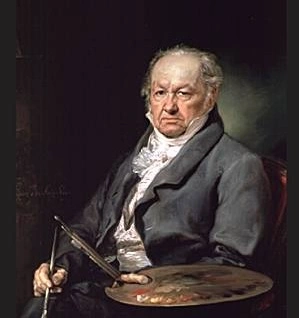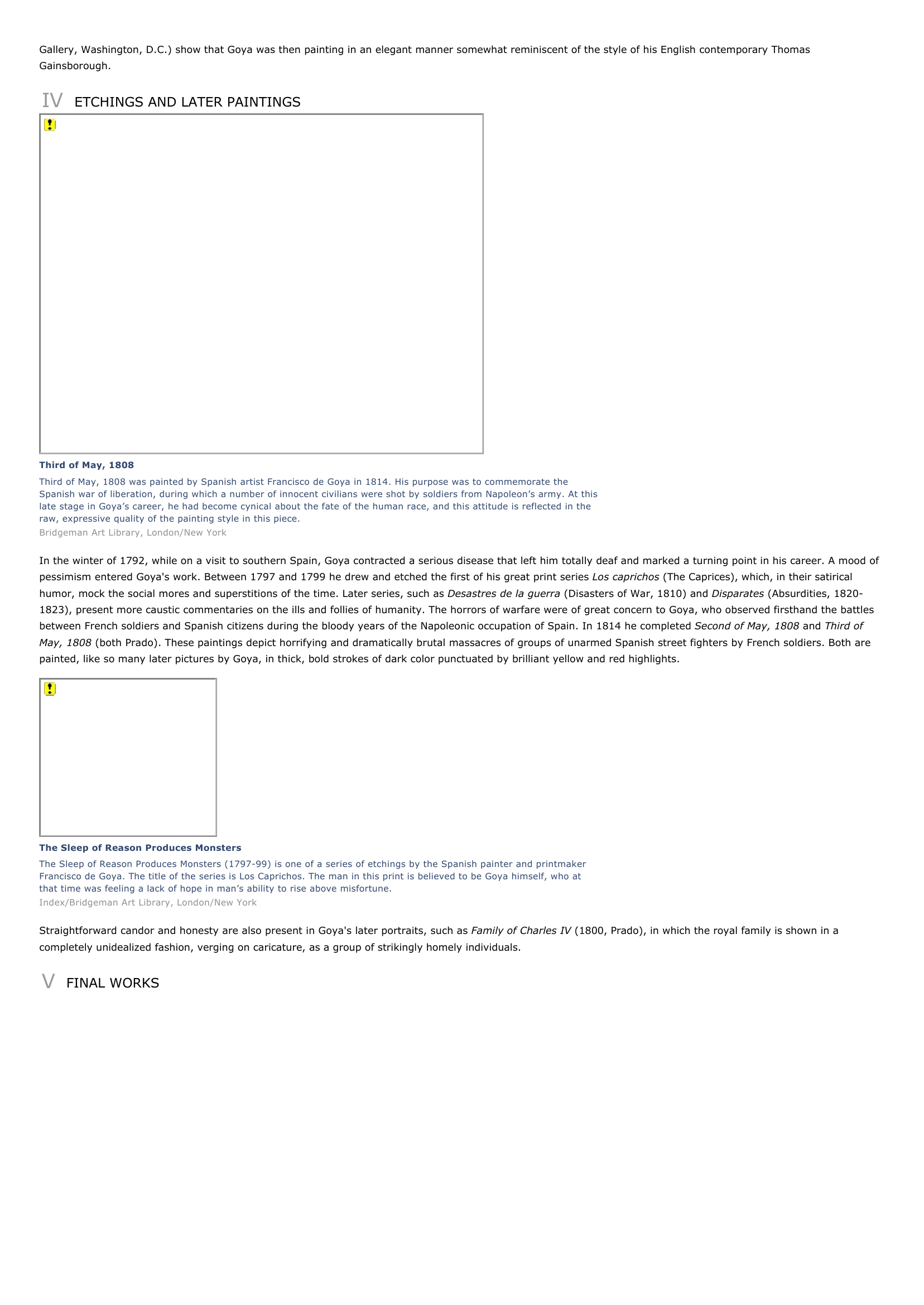Francisco José de Goya y LucientesIINTRODUCTIONFrancisco de GoyaOne of the great masters of Spanish art, painter and illustrator Francisco José de Goya y Lucientes produced works ofconsiderable beauty and power.
Publié le 12/05/2013

Extrait du document


«
Gallery, Washington, D.C.) show that Goya was then painting in an elegant manner somewhat reminiscent of the style of his English contemporary ThomasGainsborough.
IV ETCHINGS AND LATER PAINTINGS
Third of May, 1808Third of May, 1808 was painted by Spanish artist Francisco de Goya in 1814.
His purpose was to commemorate theSpanish war of liberation, during which a number of innocent civilians were shot by soldiers from Napoleon’s army.
At thislate stage in Goya’s career, he had become cynical about the fate of the human race, and this attitude is reflected in theraw, expressive quality of the painting style in this piece.Bridgeman Art Library, London/New York
In the winter of 1792, while on a visit to southern Spain, Goya contracted a serious disease that left him totally deaf and marked a turning point in his career.
A mood ofpessimism entered Goya's work.
Between 1797 and 1799 he drew and etched the first of his great print series Los caprichos (The Caprices), which, in their satirical humor, mock the social mores and superstitions of the time.
Later series, such as Desastres de la guerra (Disasters of War, 1810) and Disparates (Absurdities, 1820- 1823), present more caustic commentaries on the ills and follies of humanity.
The horrors of warfare were of great concern to Goya, who observed firsthand the battlesbetween French soldiers and Spanish citizens during the bloody years of the Napoleonic occupation of Spain.
In 1814 he completed Second of May, 1808 and Third of May, 1808 (both Prado).
These paintings depict horrifying and dramatically brutal massacres of groups of unarmed Spanish street fighters by French soldiers.
Both are painted, like so many later pictures by Goya, in thick, bold strokes of dark color punctuated by brilliant yellow and red highlights.
The Sleep of Reason Produces MonstersThe Sleep of Reason Produces Monsters (1797-99) is one of a series of etchings by the Spanish painter and printmakerFrancisco de Goya.
The title of the series is Los Caprichos.
The man in this print is believed to be Goya himself, who atthat time was feeling a lack of hope in man’s ability to rise above misfortune.Index/Bridgeman Art Library, London/New York
Straightforward candor and honesty are also present in Goya's later portraits, such as Family of Charles IV (1800, Prado), in which the royal family is shown in a completely unidealized fashion, verging on caricature, as a group of strikingly homely individuals.
V FINAL WORKS.
»
↓↓↓ APERÇU DU DOCUMENT ↓↓↓
Liens utiles
- Édouard Manet I INTRODUCTION Manet: Tradition and Innovation French impressionist painter Édouard Manet shocked art audiences in Paris with Le déjeuner sur l'herbe (The Luncheon on the Grass; 1863, Musée d'Orsay, Paris), which depicts a nude woman at a woodland picnic.
- Diego Velázquez (artist) I INTRODUCTION Velázquez and Baroque Theatricality Spanish painter Diego Velázquez presents two scenes in The Fable of Arachne (about 1656, Museo del Prado, Madrid, Spain), also known as The Spinners.
- Henri Matisse Henri Matisse (1869-1954), French artist, leader of the fauve group (see Fauvism), regarded as one of the great formative figures in 20th-century art, a master of the use of color and form to convey emotional expression.
- Indian Art and Architecture I INTRODUCTION Art on the Indian Subcontinent This map highlights places in India and Pakistan where prominent examples of Indian art and architecture have been produced.
- Japanese Art and Architecture I INTRODUCTION Otani Oniji as Eitoku Otani Oniji as Eitoku is one of a number of woodblock prints created by the artist T? sh ?sai Sharaku between 1794 and 1795 during the Edo period in Japan.























